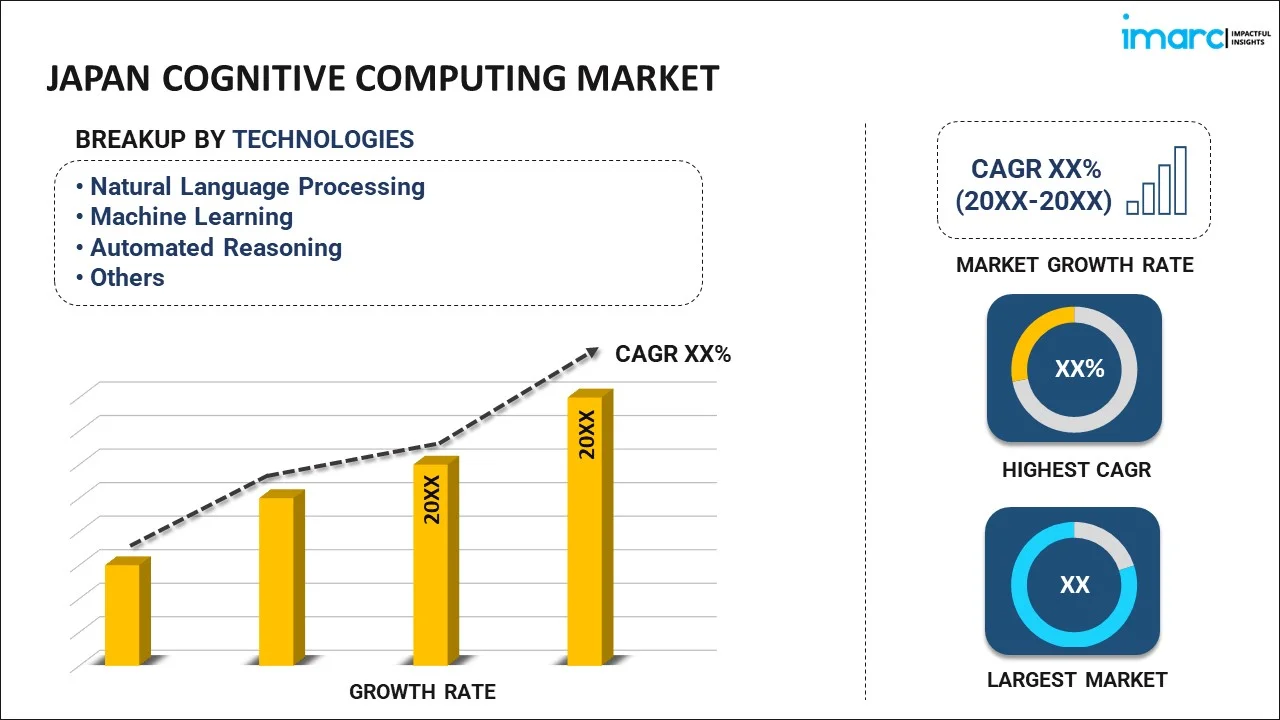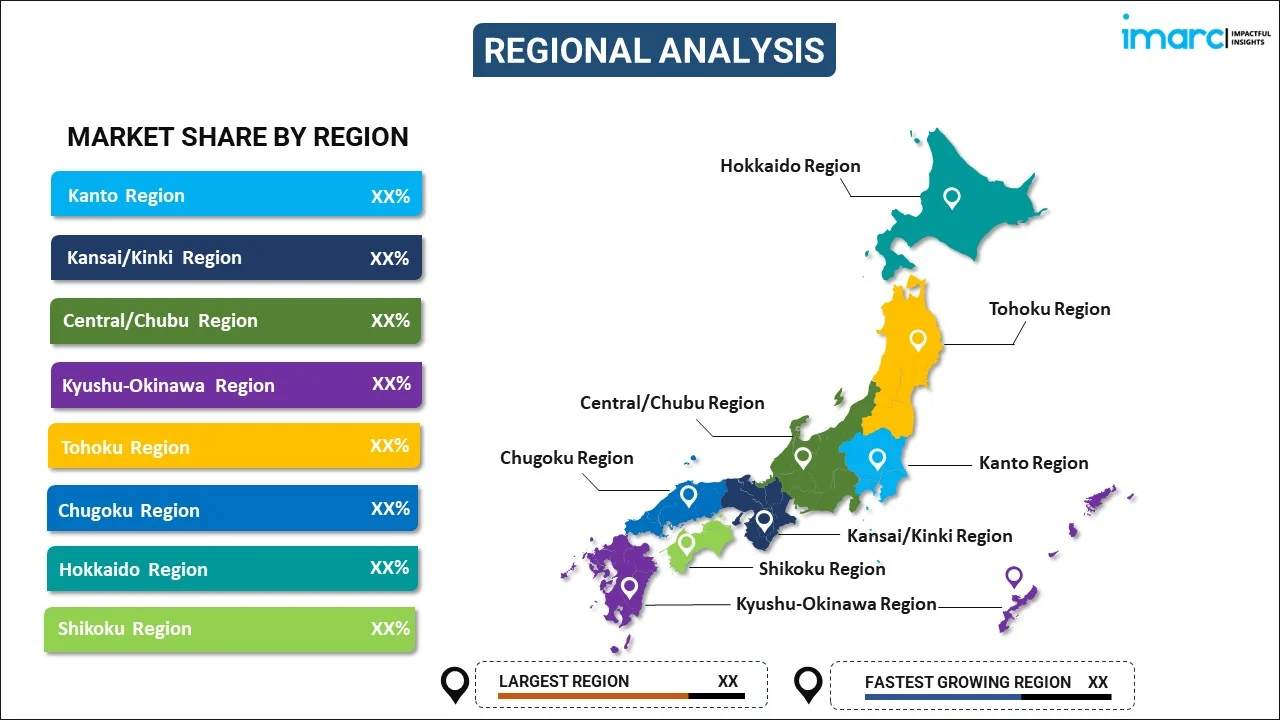
Japan Cognitive Computing Market Report by Technology (Natural Language Processing, Machine Learning, Automated Reasoning, and Others), Deployment Type (On-premises, Cloud-based), Enterprise Size (Small and Medium-sized Enterprises, Large Enterprises), Industry Vertical (Healthcare, BFSI, Retail, Government, IT and Telecom, Energy and Power, and Others), and Region 2025-2033
Market Overview:
Japan cognitive computing market size reached USD 2,951.1 Million in 2024. Looking forward, IMARC Group expects the market to reach USD 27,372.9 Million by 2033, exhibiting a growth rate (CAGR) of 28.10% during 2025-2033. The increasing demand for advanced analytics, including natural language processing (NLP), machine learning, and deep learning, to extract meaningful patterns and insights from data, is driving the market.
|
Report Attribute
|
Key Statistics
|
|---|---|
|
Base Year
|
2024 |
|
Forecast Years
|
2025-2033
|
|
Historical Years
|
2019-2024
|
| Market Size in 2024 | USD 2,951.1 Million |
| Market Forecast in 2033 | USD 27,372.9 Million |
| Market Growth Rate (2025-2033) | 28.10% |
Cognitive computing is a branch of artificial intelligence (AI) that aims to create systems capable of mimicking human thought processes. It combines various AI technologies, including NLP, machine learning, and neural networks, to enable computers to understand and interpret complex data, reason like humans, and make informed decisions. Unlike traditional computing, which relies on explicit programming, cognitive computing systems can learn from vast amounts of data and adapt to new information. They excel in tasks that involve unstructured data, such as text, images, and speech, making them valuable in areas like healthcare diagnostics, customer service, and financial analysis. Cognitive computing systems can interact with users in a more natural and conversational manner, enabling them to answer questions, provide insights, and assist in decision-making. IBM's Watson and chatbots like Siri and Alexa are examples of cognitive computing applications that are transforming industries by enhancing data analysis, problem-solving, and human-computer interaction.
Japan Cognitive Computing Market Trends:
The cognitive computing market in Japan is experiencing robust growth due to several interconnected factors. Firstly, the exponential increase in data generation and availability, coupled with the need for extracting meaningful insights from this data, has driven the demand for cognitive computing solutions. Additionally, the ever-growing complexity of business operations and decision-making processes has necessitated more advanced and adaptive systems, further propelling the market's expansion. Furthermore, the convergence of various technologies, such as artificial intelligence, machine learning, and NLP, has significantly enhanced the capabilities of cognitive computing systems. Moreover, the rising awareness among businesses about the potential benefits of cognitive computing, such as improved customer service, enhanced efficiency, and cost reduction, has acted as a significant driver. Apart from this, the growing emphasis on personalized user experiences and the need to automate routine tasks in several industries, like healthcare, finance, and manufacturing, is expected to drive the cognitive computing market in Japan during the forecast period.
Japan Cognitive Computing Market Segmentation:
IMARC Group provides an analysis of the key trends in each segment of the market, along with forecasts at the country level for 2025-2033. Our report has categorized the market based on technology, deployment type, enterprise size, and industry vertical.
Technology Insights:

- Natural Language Processing
- Machine Learning
- Automated Reasoning
- Others
The report has provided a detailed breakup and analysis of the market based on the technology. This includes natural language processing, machine learning, automated reasoning, and others.
Deployment Type Insights:
- On-premises
- Cloud-based
A detailed breakup and analysis of the market based on the deployment type have also been provided in the report. This includes on-premises and cloud-based.
Enterprise Size Insights:
- Small and Medium-sized Enterprises
- Large Enterprises
The report has provided a detailed breakup and analysis of the market based on the enterprise size. This includes small and medium-sized enterprises and large enterprises.
Industry Vertical Insights:
- Healthcare
- BFSI
- Retail
- Government
- IT and Telecom
- Energy and Power
- Others
A detailed breakup and analysis of the market based on the industry vertical have also been provided in the report. This includes healthcare, BFSI, retail, government, IT and telecom, energy and power, and others.
Regional Insights:

- Kanto Region
- Kansai/Kinki Region
- Central/ Chubu Region
- Kyushu-Okinawa Region
- Tohoku Region
- Chugoku Region
- Hokkaido Region
- Shikoku Region
The report has also provided a comprehensive analysis of all the major regional markets, which include Kanto Region, Kansai/Kinki Region, Central/ Chubu Region, Kyushu-Okinawa Region, Tohoku Region, Chugoku Region, Hokkaido Region, and Shikoku Region.
Competitive Landscape:
The market research report has also provided a comprehensive analysis of the competitive landscape. Competitive analysis such as market structure, key player positioning, top winning strategies, competitive dashboard, and company evaluation quadrant has been covered in the report. Also, detailed profiles of all major companies have been provided.
Japan Cognitive Computing Market Report Coverage:
| Report Features | Details |
|---|---|
| Base Year of the Analysis | 2024 |
| Historical Period | 2019-2024 |
| Forecast Period | 2025-2033 |
| Units | Million USD |
| Scope of the Report | Exploration of Historical and Forecast Trends, Industry Catalysts and Challenges, Segment-Wise Historical and Predictive Market Assessment:
|
| Technologies Covered | Natural Language Processing, Machine Learning, Automated Reasoning, Others |
| Deployment Types Covered | On-premises, Cloud-based |
| Enterprise Sizes Covered | Small and Medium-sized Enterprises, Large Enterprises |
| Industry Verticals Covered | Healthcare, BFSI, Retail, Government, IT and Telecom, Energy and Power, Others |
| Regions Covered | Kanto Region, Kansai/Kinki Region, Central/ Chubu Region, Kyushu-Okinawa Region, Tohoku Region, Chugoku Region, Hokkaido Region, Shikoku Region |
| Customization Scope | 10% Free Customization |
| Post-Sale Analyst Support | 10-12 Weeks |
| Delivery Format | PDF and Excel through Email (We can also provide the editable version of the report in PPT/Word format on special request) |
Key Questions Answered in This Report:
- How has the Japan cognitive computing market performed so far and how will it perform in the coming years?
- What has been the impact of COVID-19 on the Japan cognitive computing market?
- What is the breakup of the Japan cognitive computing market on the basis of technology?
- What is the breakup of the Japan cognitive computing market on the basis of deployment type?
- What is the breakup of the Japan cognitive computing market on the basis of enterprise size?
- What is the breakup of the Japan cognitive computing market on the basis of industry vertical?
- What are the various stages in the value chain of the Japan cognitive computing market?
- What are the key driving factors and challenges in the Japan cognitive computing?
- What is the structure of the Japan cognitive computing market and who are the key players?
- What is the degree of competition in the Japan cognitive computing market?
Key Benefits for Stakeholders:
- IMARC’s industry report offers a comprehensive quantitative analysis of various market segments, historical and current market trends, market forecasts, and dynamics of the Japan cognitive computing market from 2019-2033.
- The research report provides the latest information on the market drivers, challenges, and opportunities in the Japan cognitive computing market.
- Porter's five forces analysis assist stakeholders in assessing the impact of new entrants, competitive rivalry, supplier power, buyer power, and the threat of substitution. It helps stakeholders to analyze the level of competition within the Japan cognitive computing industry and its attractiveness.
- Competitive landscape allows stakeholders to understand their competitive environment and provides an insight into the current positions of key players in the market.
Need more help?
- Speak to our experienced analysts for insights on the current market scenarios.
- Include additional segments and countries to customize the report as per your requirement.
- Gain an unparalleled competitive advantage in your domain by understanding how to utilize the report and positively impacting your operations and revenue.
- For further assistance, please connect with our analysts.
 Inquire Before Buying
Inquire Before Buying
 Speak to an Analyst
Speak to an Analyst
 Request Brochure
Request Brochure
 Request Customization
Request Customization




.webp)




.webp)












